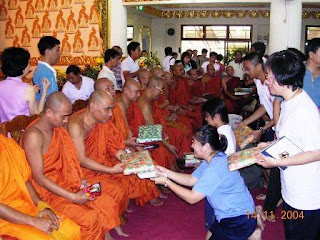Mahayana Buddhism
Mahayana Buddhism emerged in the first century CE as a more liberal, accessible interpretation of Buddhism. As the "Greater Vehicle" (literally, the "Greater Ox-Cart"), Mahayana is a path available to people from all walks of life - not just monks and ascetics.
Mahayana Buddhism is the primary form of Buddhism in North Asia and the Far East, including China, Japan, Korea, Tibet and Mongolia, and is thus sometimes known as Northern Buddhism. Mahayana Buddhists accept the Pali Canon as sacred scripture with the Theravadans, but also many other works, the Sutras, which were written later and in Sanskrit.
Theravada and Mahayana Buddhists differ in their perspective on the ultimate purpose of life and the way in which it can be attained. As discussed on the last page, Theravada Buddhists strive to become arhats, or perfected saints who have attained enlightenment and nirvana. This is considered to only be possible for monks and nuns, who devote their entire lives to the task. The best outcome the laity can hope for is to be reborn in the monastic life.
Mahayana Buddhists, on the other hand, hope to become not arhats but boddhisatvas, saints who have become enlightened but who unselfishly delay nirvana to help others attain it as well, as the Buddha did. Perhaps more significantly for one who would choose between the paths, Mahayana Buddhists teach that enlightenment can be attained in a single lifetime, and this can be accomplished even by a layperson. The various subdivisions within the Mahayana tradition, such as Zen, Nichiren, and Pure Land, promote different ways of attaining this goal, but all are agreed that it can be attained in a single lifetime by anyone who puts his or her mind (and sometimes body) to it.
The Mahayana form of Buddhism tends to be more religious in nature than its Theravadan counterpart. It often includes veneration of celestial beings, Buddhas and boddhisatvas, ceremonies, religious rituals, magical rites, and the use of icons, images, and other sacred objects. The role of such religious elements varies, however: it is central to Tibetan/Tantric Buddhism, but is highly discouraged by Zen practitioners, who have been known to burn statues of the Buddha to demonstrate their unimportance.
Mahayana Buddhism is the primary form of Buddhism in North Asia and the Far East, including China, Japan, Korea, Tibet and Mongolia, and is thus sometimes known as Northern Buddhism. Mahayana Buddhists accept the Pali Canon as sacred scripture with the Theravadans, but also many other works, the Sutras, which were written later and in Sanskrit.
Theravada and Mahayana Buddhists differ in their perspective on the ultimate purpose of life and the way in which it can be attained. As discussed on the last page, Theravada Buddhists strive to become arhats, or perfected saints who have attained enlightenment and nirvana. This is considered to only be possible for monks and nuns, who devote their entire lives to the task. The best outcome the laity can hope for is to be reborn in the monastic life.
Mahayana Buddhists, on the other hand, hope to become not arhats but boddhisatvas, saints who have become enlightened but who unselfishly delay nirvana to help others attain it as well, as the Buddha did. Perhaps more significantly for one who would choose between the paths, Mahayana Buddhists teach that enlightenment can be attained in a single lifetime, and this can be accomplished even by a layperson. The various subdivisions within the Mahayana tradition, such as Zen, Nichiren, and Pure Land, promote different ways of attaining this goal, but all are agreed that it can be attained in a single lifetime by anyone who puts his or her mind (and sometimes body) to it.
The Mahayana form of Buddhism tends to be more religious in nature than its Theravadan counterpart. It often includes veneration of celestial beings, Buddhas and boddhisatvas, ceremonies, religious rituals, magical rites, and the use of icons, images, and other sacred objects. The role of such religious elements varies, however: it is central to Tibetan/Tantric Buddhism, but is highly discouraged by Zen practitioners, who have been known to burn statues of the Buddha to demonstrate their unimportance.



Comments